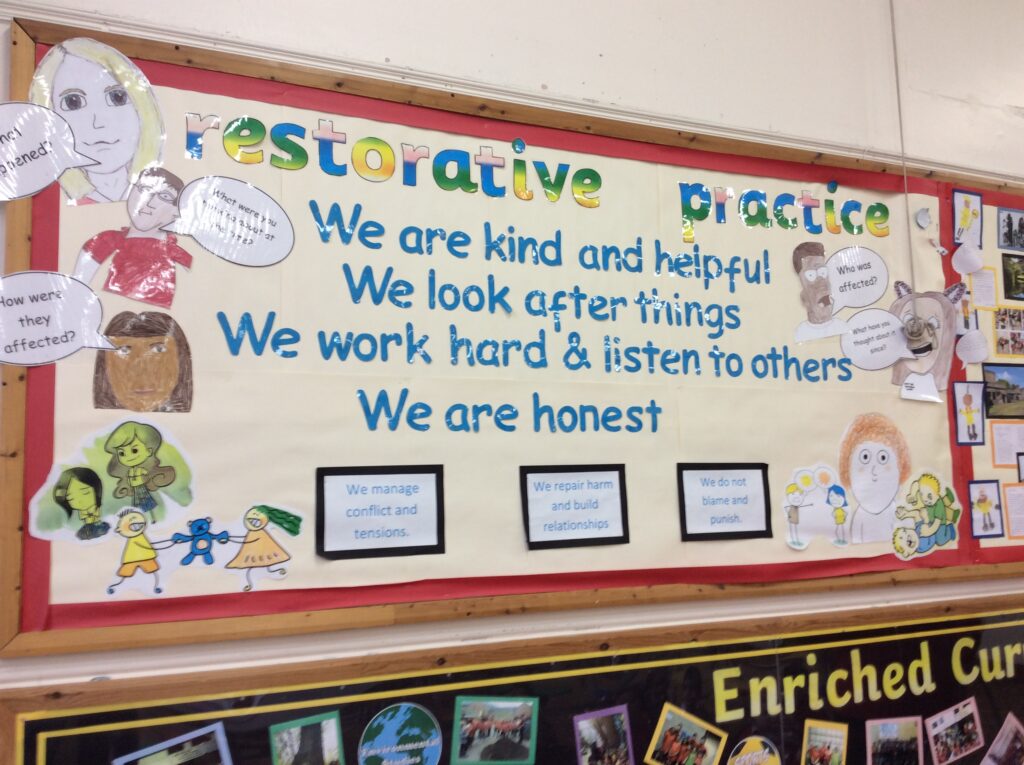RESTORATIVE PRACTICE

WHAT IS RESTORATIVE PRACTICE?
Restorative Practice is a way to be, not a process to follow or a thing to do at certain times. It’s a term used to describe principles, behaviours and approaches which build and maintain healthy relationships and a sense of community and can resolve difficulties and repair harm where there has been conflict.
HOW DOES IT WORK?
A restorative approach is a culture or ethos with the following practical goals:
to reduce the likelihood of conflict and/or recurrence of conflict by taking a whole-setting approach to meeting human needs;
to strengthen relationships by making time for open and honest conversations that need to be had.
A restorative setting understands that children, families and staff give their best when their needs are met, when they feel safe and when they understand their relationships with others.
It allows time to listen to the voice of individuals, staff and families. It wants to hear people’s stories, help them clarify their issues and needs, and empower them to find their own solutions to what is concerning them.
A restorative setting understands that children, families and staff give their best when their needs are met, when they feel safe and when they understand their relationships with others.
It allows time to listen to the voice of individuals, staff and families. It wants to hear people’s stories, help them clarify their issues and needs, and empower them to find their own solutions to what is concerning them.
WHAT ARE THE BENEFITS OF RESTORATIVE APPROACHES IN SCHOOL?
Experience and evidence at local and national levels has shown that restorative processes have a positive impact in changing school cultures, especially regarding attendance and behaviour, when embedded in a wider restorative context, and within clear school improvement strategies.
A report published by the Department for Education gave whole-school restorative approaches the highest rating of effectiveness at preventing bullying, with a survey of schools showing 97% rated restorative approaches as effective.
An independent evaluation of restorative justice in Bristol schools found that restorative justice improved school attendance and reduced exclusion rates.
On a practical level, restorative approaches provide a structured and consistent response to the inevitable incidents of conflict that arise in the life of a school. The benefits of improved conflict resolution in schools lead to reduced disruption of teaching and learning, improved relationships and a calmer school environment.
In addition to the conflict resolution benefits, restorative approaches have been shown to develop people’s social and emotional competencies, such as increased empathy, improved self-discipline and more responsible decision-making. These benefits contribute to pupils’ personal, social and moral development.
A report published by the Department for Education gave whole-school restorative approaches the highest rating of effectiveness at preventing bullying, with a survey of schools showing 97% rated restorative approaches as effective.
An independent evaluation of restorative justice in Bristol schools found that restorative justice improved school attendance and reduced exclusion rates.
On a practical level, restorative approaches provide a structured and consistent response to the inevitable incidents of conflict that arise in the life of a school. The benefits of improved conflict resolution in schools lead to reduced disruption of teaching and learning, improved relationships and a calmer school environment.
In addition to the conflict resolution benefits, restorative approaches have been shown to develop people’s social and emotional competencies, such as increased empathy, improved self-discipline and more responsible decision-making. These benefits contribute to pupils’ personal, social and moral development.
RESTORATIVE PRACTICE AT PORTER CROFT
All staff carry the ‘Restorative Questions’ in their name tags so that it is part of everyday life at Porter Croft

